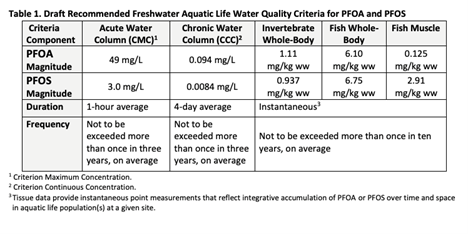Clean Water Current
EPA Releases Trio of PFAS Updates Impacting Clean Water Utility Sector
EPA published its Draft Recommended Aquatic Life Ambient Water Quality Criteria (AWQC) for Perfluorooctanoic Acid (PFOA) and Perfluorooctane Sulfonic Acid (PFOS) in the Federal Register on May 3.
The draft recommended AWQC reflect observed life history effects of PFOA and PFOS on a variety of aquatic species, including effects on survival, growth, and reproduction. The AWQC for aquatic life demonstrate the maximum individual concentrations of PFOA and PFOS in frequency and duration that protect aquatic life from short-term and chronic effects in freshwater.
These criteria values are recommendations for states to consider when adopting water quality standards.

EPA continues its efforts under its PFAS Strategic Roadmap, specifically indicating its intent to finalize AWQC for aquatic life by Winter 2022. The Agency also continues to work on its recommended human health ambient water quality criteria for PFOA and PFOS, which will likely be much lower in concentration than the draft aquatic life criteria.
EPA has set a short 30-day turnaround time for public comment on the draft AWQC. As of now, comments are due June 2, 2022.
EPA also announced a new screening methodology to measure PFAS in wastewater, Method 1621. Method 1621 measures absorbable organic fluorine (AOF) in aqueous matrices using combustion ion chromatography. This method does not target individual PFAS chemicals but rather measures total organofluorine concentrations in wastewater.
NACWA has had concerns with total fluorine methodologies in the past as they do not fingerprint any individual PFAS chemical and do not assist the clean water community with identifying upstream industrial source contributions. While this method may be a scientific technique that captures all fluorine present in any given matrix, it is imperative – and EPA has indeed noted – that this method could and should be used with other methods to target individual PFAS.
Method 1621 is through single-laboratory validation and is headed for multi-lab validation this summer. NACWA is reviewing the method and the corresponding validation report.
Lastly, EPA published a short memorandum to Regional Water Division Directors on Addressing PFAS Discharges in EPA-Issued NPDES Permits and Expectations where EPA is the Pretreatment Control Authority.
EPA has already issued its first draft NPDES permit in Massachusetts which does include pretreatment monitoring requirements. This memorandum is helpful guidance for utilities in Massachusetts as well as others across the country to consider as they look upstream for PFAS sources and begin to update industrial user inventories, seek best management practices or local limits, and develop notification requirements to downstream public water systems.
NACWA is reviewing all three of these updates and is preparing comments on EPA’s recommended draft aquatic life criteria. If members have thoughts or concerns with EPA’s recent PFAS updates, please contact Emily Remmel, NACWA’s Director of Regulatory Affairs